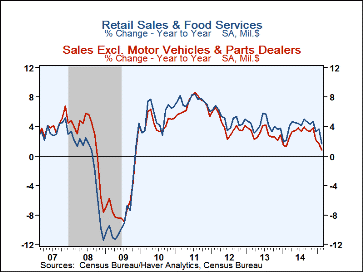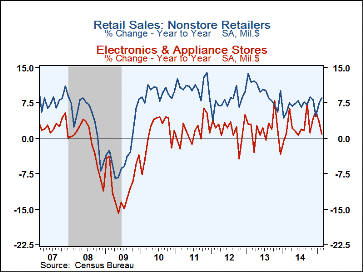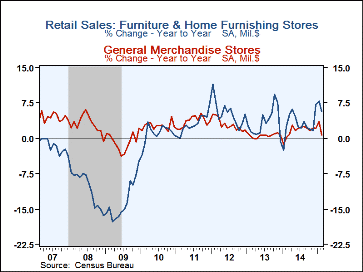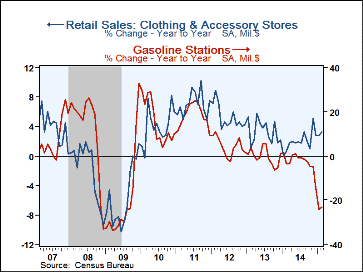 Global| Mar 12 2015
Global| Mar 12 2015U.S. Retail Sales Disappoint, Falling for Three Straight Months
by:Tom Moeller
|in:Economy in Brief
Summary
Severe winter weather may have been a factor last month, but retail spending has been under pressure for a while. Overall retail sales including food services & drinking places fell 0.6% (+1.7% y/y) during February following an [...]
Severe winter weather may have been a factor last month, but retail spending has been under pressure for a while. Overall retail sales including food services & drinking places fell 0.6% (+1.7% y/y) during February following an unrevised 0.8% decline in January. It was the third straight monthly shortfall. A 0.4% increase had been expected in the Action Economics Forecast Survey. Sales excluding autos slipped 0.1% (+0.8% y/y) after a 1.1% decline. It also was the third straight down month. A 0.6% increase had been expected. During the last ten years, there has been a 92% correlation between the y/y change in retail sales and the change in real GDP. Sales in the retail control group exclude autos, gasoline, building materials & food services and align with the estimates in the GDP accounts. It was unchanged last month (+3.7% y/y) after two months of slight decline.
A 2.5% decline in auto sales (+5.4% y/y) pulled overall retail spending down last month as it followed a 0.5% rise. The fall coincides with a 2.6% deterioration in unit vehicle sales. Sales of building materials were off 2.3% (+3.9% y/y) following a 0.7% improvement.
Sales of nonstore retailers posted a 2.2% increase (8.6% y/y) after a 0.3% rise. Purchases at electronics & appliance stores, however, fell 1.2% (+0.9% y/y), the fourth decline in the last five months. Sales at furniture & home furnishings outlets ticked 0.1% lower (+5.8% y/y), the third slight decline in the last four months. Apparel store sales were roughly unchanged (+3.3% y/y), weak for the third consecutive month, and general merchandise store sales declined 1.2% (+0.8% y/y) after a 0.1% uptick. Sporting goods, hobby, book & music store sales increased 2.3% (3.5% y/y) following three months of decline. Food service and drinking place sales fell 0.6% (7.7% y/y) after a 1.2% dip.
In the nondiscretionary sales categories, health & personal care store sales fell 0.7% (+4.8% y/y) after a 0.3% decline. Food & beverage store sales moved 0.3% higher (3.6% y/y) after a 0.2% drop.
The retail sales figures are available in Haver's USECON database. The Action Economics figures are in the AS1REPNA database.
| Retail Spending (%) | Feb | Jan | Dec | Feb Y/Y | 2014 | 2013 | 2012 |
|---|---|---|---|---|---|---|---|
| Total Retail Sales & Food Services | -0.6 | -0.8 | -0.9 | 1.7 | 4.0 | 4.2 | 5.1 |
| Excluding Autos | -0.1 | -1.1 | -0.8 | 0.8 | 3.0 | 3.0 | 4.2 |
| Non-Auto Less Gasoline, Building Supplies & Food Services | 0.0 | -0.1 | -0.2 | 3.7 | 3.3 | 3.3 | 3.6 |
| Retail Sales | -0.6 | -0.9 | -1.1 | 1.0 | 3.8 | 4.3 | 5.0 |
| Motor Vehicle & Parts | -2.5 | 0.5 | -1.1 | 5.4 | 8.1 | 9.3 | 9.1 |
| Retail Less Autos | 0.0 | -1.3 | -1.2 | -0.3 | 2.6 | 3.0 | 4.0 |
| Gasoline Stations | 1.5 | -9.8 | -7.5 | -23.0 | -2.8 | -0.3 | 4.2 |
| Food Service & Drinking Places Sales | -0.6 | -0.2 | 1.2 | 7.7 | 5.9 | 3.0 | 5.9 |
Tom Moeller
AuthorMore in Author Profile »Prior to joining Haver Analytics in 2000, Mr. Moeller worked as the Economist at Chancellor Capital Management from 1985 to 1999. There, he developed comprehensive economic forecasts and interpreted economic data for equity and fixed income portfolio managers. Also at Chancellor, Mr. Moeller worked as an equity analyst and was responsible for researching and rating companies in the economically sensitive automobile and housing industries for investment in Chancellor’s equity portfolio. Prior to joining Chancellor, Mr. Moeller was an Economist at Citibank from 1979 to 1984. He also analyzed pricing behavior in the metals industry for the Council on Wage and Price Stability in Washington, D.C. In 1999, Mr. Moeller received the award for most accurate forecast from the Forecasters' Club of New York. From 1990 to 1992 he was President of the New York Association for Business Economists. Mr. Moeller earned an M.B.A. in Finance from Fordham University, where he graduated in 1987. He holds a Bachelor of Arts in Economics from George Washington University.










